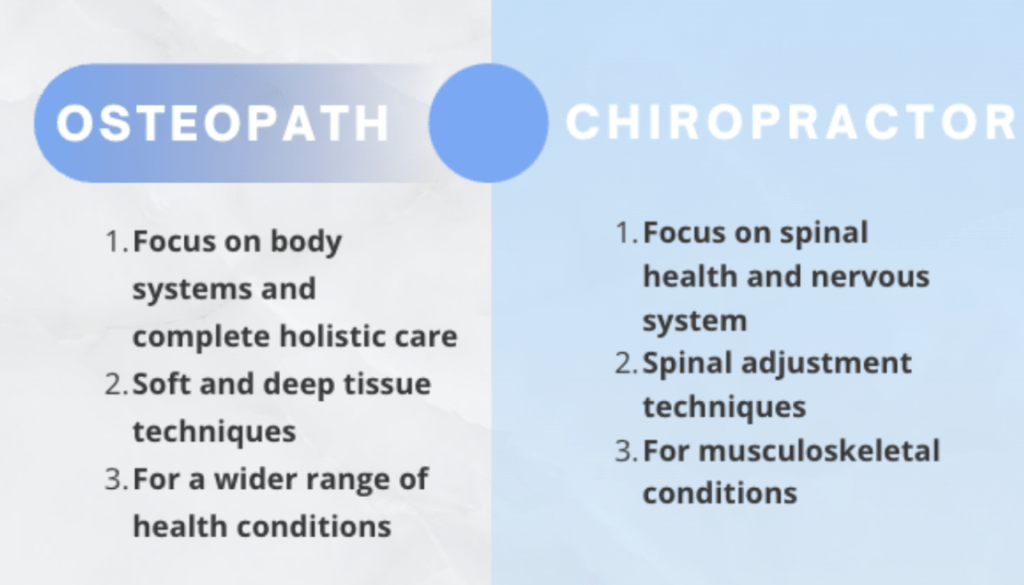In the last decade, the demand for complementary and alternative therapies such as osteopathy and chiropractic care has grown. These fields present complementary approaches to improve general health and reduce pain. However, those in search of the best treatment for their specific requirements should understand the subtle differences between osteopathy and chiropractic care, which we cover in this blog post.
Understanding Osteopathy
Osteopathy is a therapeutic approach founded on the concept that the body has a natural capacity for healing itself. Osteopaths have a holistic point of view, understanding the body as a one integrated system in which the neurological system, musculoskeletal system, and other physiological systems all work together. Manual techniques that osteopaths use include joint mobilisation, soft and deep tissue manipulation, and neuromuscular techniques. The discipline of craniosacral osteopathy is a specific branch of osteopathy that can gently manipulate the head, neck and sacrum area to treat nervous system disorders such as headaches and migraines. All these techniques are essential to osteopathic practice and are used for enhancing general health and restoring the body back to balance.
When to see an Osteopath
Osteopathy is extremely useful for people with acute or chronic conditions. For muscle tensions, spasms, and acute sprains and strains, osteopathy can be helpful when treated quickly after the acute pain. For chronic conditions where pain lasts for longer than 6 weeks such as arthritis, back pain, sports injuries, and long standing postural problems, it is highly advisable to see an osteopath to create a treatment plan. Osteopathic treatment may also be beneficial to individuals wanting to improve their sports recovery after intense workouts or even obtain preventive healthcare.
Understanding Chiropractic Care
Although some osteopathy does focus on spinal manipulation techniques to a certain extent, chiropractors more strongly emphasise the importance of spinal health in their primary practice, with a special focus on the relationship between the spine and the neurological system. Chiropractic care focuses on diagnosing and treating vertebral subluxations, also known as misalignments or dysfunctions of the spine, in order to normalise nervous system function. The mainstay of chiropractic care is spinal manipulation and adjustment, which is intended to enhance nerve function, reduce pain, and realign the spine.
When to see a Chiropractor
Patients with back and neck pain, headaches, and musculoskeletal problems resulting from misaligned spines often turn to chiropractic care. Chiropractic treatment may be useful for those who are searching for relief from either acute or chronic pain relating to the spine.
Overall, osteopathy can be the best option for you if you’re seeking a healthcare provider that takes a more holistic approach, whereas chiropractic treatments can be more appropriate if you are looking for relief from a particular vertebral problem.
What is the difference between an osteopath and a chiropractor?
Both practices have similarities and differences, but there are 3 main differences you should be aware of:
- Philosophy and approach
Osteopathy advocates for a complete approach, with a focus on manual therapies and therapeutic exercises meant to bring the body back into balance. On the other hand, adjustments to the spinal column are a vital aspect of chiropractic treatment, which focuses primarily on the health of the spine and the nervous system.
- Type of techniques
The practice of osteopathy uses a broad spectrum of manual treatments, including soft tissue manipulation, mobility of joints, and stretching exercises. Osteopathic medicine’s holistic approach may be more beneficial to people needing medical care for all aspects of their health. Additionally, osteopathic traditional methods allow for flexible management of an array of diseases.
Chiropractors work mostly on the spine and primarily utilise adjustments or manipulations, along with adjunctive therapies such as heat therapy, electrical stimulation, and rehabilitative exercises. For those specifically seeking spinal adjustments or focusing on spinal health, chiropractic care may be the preferred choice.
- Diagnostic methods
Osteopaths typically rely on physical examination and palpation to assess musculoskeletal issues and identify areas of dysfunction. On the other hand, chiropractors may use diagnostic tools such as X-rays to visualise spinal misalignments and guide their treatment approach.
- Certifications and training
Osteopaths are usually regulated by professional bodies, such as the General Osteopathic Council (GOC) in the UK. Whereas, chiropractors must be regulated by the General Chiropractic Council (GCC).

Should you choose an osteopath or chiropractor
While both osteopathic and chiropractic treatments offer suitable benefits in this modern healthcare climate, the choice between the two may depend on individual preferences and the nature of the condition being treated. It’s essential to weigh your health care needs first, and then evaluate the differences in philosophy and approach between the two disciplines to decide which one is best for you.
At the Complementary Health Clinic, our experienced osteopath offers personalised osteopathic care tailored to your individual needs. Whether you’re seeking relief from pain, enhancing your overall well-being, or addressing specific health concerns, we’re here to support you on your journey to optimal health. Call us today on 01733 774 440 to schedule a consultation and discover how our registered osteopath can tailor your treatment to benefit you.